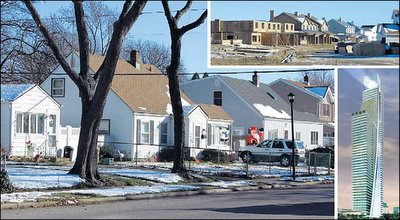
No matter how many American downtowns get redeveloped and revitalized, there remains an unmistakable obsession with the suburbs. To wit: "Sprawl: A Concise History," a new book by Robert Bruegmann, an urban planning egghead at the University of Illinois, Chicago. He makes a contrarian argument in favor of suburbia on a populist soap box; namely, it is the liberal elites who oppose sprawl even though, were it not for the suburbs, many people would not be able to partake in the good life that the liberal elites so enjoy. And I will admit there's enough truth to this argument to entice me to actually read the book. But from what I've read about the book, the author neglects to address what happens to a city when there is sprawl without population growth, which is the cause of death for essentially the entire middle section of the country, save for Chicago, where he just so happens to live (i.e. there's an important distinction between "surburia" and "sprawl").
More interestingly, a recent article in the Times asked, "What is the future of suburbia in America?" The article notes the life cycle of suburbia and how Long Island is at the crisis point: "local taxes are among the nation's highest, gangs, traffic jams, pockets of poverty and decay, dwindling open space, insufficient mass transit, segregation, blighted strip malls, an influx of immigrants, sprawl and a lack of focal points for community life." In other words, it's the inner-ring suburb syndrome writ large.
Long Island needs to reinvent itself, and lo-and-behold, one of the more promsing options is to urbanize, especially by applying urban revitalization techniques that have revived downtowns from Providence to Albuquerque. What's more: "Some call for radical transformation, even a startling new look. A couple of miles from Levittown, in Uniondale, Charles B. Wang proposed something never before contemplated on Long Island: the Great Lighthouse, with a luxury hotel and condominiums, topped by an observation deck and a large shiny ball visible for miles" (pictured above, inset).
Suburbia, of course, is not going away and nor should it. I don't hear liberal elites (or even E.Villagers for that matter), walking around complaining about the horrors of suburbia ... that's so '80s. All we are saying is, give density a chance.
P.S. I've been alerted by Starts and Fits that Wong has dropped his plans to build a tower on Long Island. I can't say I was crazy about that idea to begin with, but that doesn't mean that certain parts of Long Island shouldn't densify to revitalize itself.
Photographs, above and inset, by Barton Silverman/The New York Times
